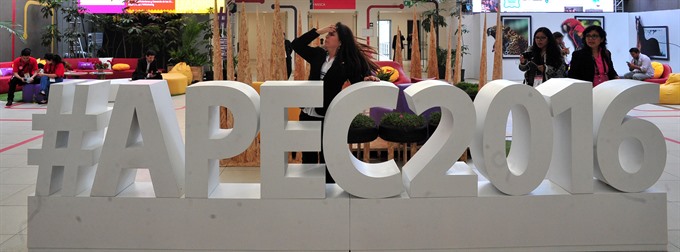 World
World

Foreign and trade ministers from 21 Pacific Rim economies pledged Thursday to promote free trade in the face of rising protectionism, Japan’s trade minister said, in a veiled counter to US President-elect Donald Trump and his anti-globalism rhetoric.
 |
| A woman gestures next to an APEC logo at the Lima Convention Centre, during the Asia-Pacific Economic Cooperation (APEC) Summit on Thursday in Lima. Top world leaders from the 21 members of APEC --which account for nearly 60 percent of the global economy and 40 percent of the world’s population-- are meeting from November 14-20, to try to save their cherished free trade accords from feared extinction under US President-elect Donald Trump. — AFP/VNA Photo |
LIMA — Foreign and trade ministers from 21 Pacific Rim economies pledged Thursday to promote free trade in the face of rising protectionism, Japan’s trade minister said, in a veiled counter to US President-elect Donald Trump and his anti-globalism rhetoric.
"We agreed to push forward free trade to counter protectionist sentiments," Economy, Trade and Industry Minister Hiroshige Seko told reporters on the first day of a two-day ministerial meeting of the Asia-Pacific Economic Co-operation forum in Lima.
Separately, Japanese Foreign Minister Fumio Kishida said APEC members must show a "strong commitment" to free trade, especially following Trump’s win in the US presidential election on November 8.
"The world economy faces various downside risks and skeptical views about free trade are spreading," Kishida told Thursday’s session. "It’s time for APEC to show a strong commitment to free trade and contribute to sustainable growth and prosperity in the Asia-Pacific region."
Kishida said it is vital that Japan, the United States and 10 other Pacific Rim countries "steadily promote" the Trans-Pacific Partnership, a 12-nation free trade agreement Trump has pledged to scrap once he takes office in January.
"It is important that each member country make efforts to create an environment conducive to early implementation of the TPP," he said, expressing hope for progress in domestic procedures such as ratification by parliaments in member states including the United States.
Kishida also called for advancing the Regional Comprehensive Economic Partnership, a 16-nation, lower-standard regional FTA that does not include the United States.
Seko said the TPP and RCEP are not contradictory because they both serve as bases for a broader, APEC-wide FTA called a Free Trade Area of the Asia-Pacific, according to a Japanese delegate.
Seko, nonetheless, was quoted by the delegate as saying a swift implementation of the TPP, often called a 21st century trade agreement, will be important to realize an FTAAP as an inclusive and high-quality deal.
Trump’s opposition to the TPP, which he said would cost millions of US jobs and destroy US manufacturing, casts a shadow over a series of talks in Lima on ways to promote trade liberalisation and regional economic integration.
Aside from the APEC ministerial session, a TPP ministerial meeting is slated for Friday, a TPP summit for Saturday and an APEC summit for Saturday and Sunday, according to Japanese officials.
US President Barack Obama has championed the TPP, vowing to write high-standard trade rules for the fast-growing region as the centerpiece of his policy of strategic rebalance to Asia in response to the rise of China, a non-TPP party.
While there is now little chance of the TPP being voted on in the US Congress before Obama leaves office in January, Chinese officials have said Beijing will push the RCEP, which groups the 10 members of the Association of Southeast Asian Nations plus Japan, China, South Korea, India, Australia and New Zealand.
Meanwhile, Japanese Prime Minister Shinzo Abe and his Malaysian counterpart Najib Abdul Razak agreed on Wednesday to push for the early implementation of the TPP.
Speaking to reporters after talks in Tokyo, Najib expressed hope that "the strategic importance of the TPP will be recognised by the incoming (US) administration."
APEC groups the TPP members -- Australia, Brunei, Canada, Chile, Japan, Malaysia, Mexico, New Zealand, Peru, Singapore, the United States and Vietnam -- and mainland China, Hong Kong, Indonesia, Papua New Guinea, the Philippines, Russia, South Korea, Taiwan and Thailand. — KYODO




